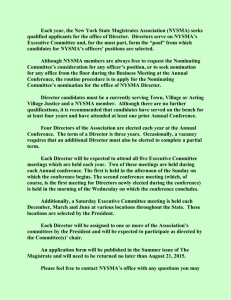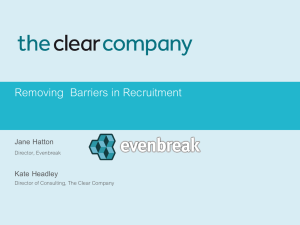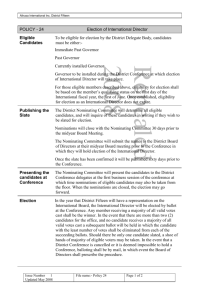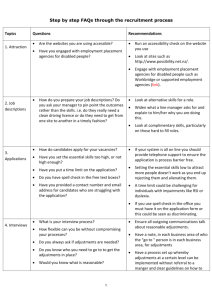MS WORD - Zero Project
advertisement
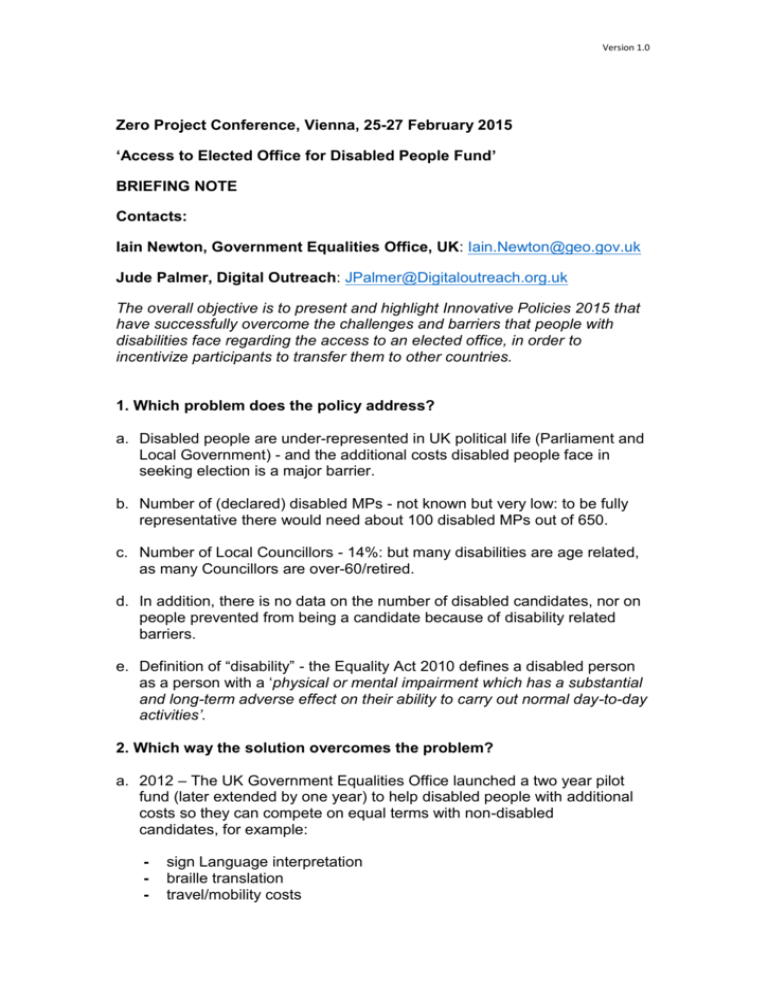
Version 1.0 Zero Project Conference, Vienna, 25-27 February 2015 ‘Access to Elected Office for Disabled People Fund’ BRIEFING NOTE Contacts: Iain Newton, Government Equalities Office, UK: Iain.Newton@geo.gov.uk Jude Palmer, Digital Outreach: JPalmer@Digitaloutreach.org.uk The overall objective is to present and highlight Innovative Policies 2015 that have successfully overcome the challenges and barriers that people with disabilities face regarding the access to an elected office, in order to incentivize participants to transfer them to other countries. 1. Which problem does the policy address? a. Disabled people are under-represented in UK political life (Parliament and Local Government) - and the additional costs disabled people face in seeking election is a major barrier. b. Number of (declared) disabled MPs - not known but very low: to be fully representative there would need about 100 disabled MPs out of 650. c. Number of Local Councillors - 14%: but many disabilities are age related, as many Councillors are over-60/retired. d. In addition, there is no data on the number of disabled candidates, nor on people prevented from being a candidate because of disability related barriers. e. Definition of “disability” - the Equality Act 2010 defines a disabled person as a person with a ‘physical or mental impairment which has a substantial and long-term adverse effect on their ability to carry out normal day-to-day activities’. 2. Which way the solution overcomes the problem? a. 2012 – The UK Government Equalities Office launched a two year pilot fund (later extended by one year) to help disabled people with additional costs so they can compete on equal terms with non-disabled candidates, for example: - sign Language interpretation braille translation travel/mobility costs Version 1.0 - carer support b. Pilot Fund will provide information on - Demand and cost for this type of support. - Practical considerations for applicants (including accessibility of the application process). - Key considerations for the Fund Administrator, as disability barriers and election campaigns vary considerably in complexity c. Without commitment, the Fund pilot will inform a decision by the UK Government after the May 2015 General Election on the future of the Fund and on other ways of helping disabled candidates in this context. 3. Why this is innovative? a. Achieving a “level playing field “ for disabled candidates is difficult because we have to balance flexibility with legal certainty through a combination of : - Ensuring compliance with laws on candidates’ elections expenses. - Identifying the additional costs candidates will face - as opposed to campaigning costs which all candidates face (candidate deposits, leaflet printing costs, etc.). - Separating candidates’ election activities from normal day to day activities: e.g. where IT equipment is being funded. - Also, recognising that many candidates need several attempts to get selected/elected. 4. Which inspiring outcomes the policy has. a. Outcomes so far: - 95 people have applied to date - 36 people have stood for election - 4 people have been elected, to our knowledge.(NB - data still being collected) - the total value of Grants awarded to date (from July 2012 to January 2015) is £399,061 b. The final figures will be known after the General Election and Local elections in May 2015. c. The case studies publication www.a2eo.wordpress.com 1 Version 1.0 d. Shows how important the Fund has been for disabled candidates. To transfer, or to support the transfer, of the policy, participants would need also to know: 5. Which stakeholders are needed to set it up? a. A GEO Chaired Stakeholder Group was formed to develop the Fund pilot, comprising representatives from: - Main disability charities (including disabled people) – critical that disabled people involved at all stages. - Main UK Political Parties. - Local Government, also representing Independent Candidates and minor parties. - Government Departments: Cabinet Office (election law), Office for Disability Issues. b. Also, disability and election experts are members of the Fund Administrator’s Advisory Panel - advising as necessary on individual applications. 6. Which key policy features does one need to have? a. Commitment by Government, Parliament and Local Government to increasing number of disabled candidates and elected representatives. b. Cross - Party support: this issue to be “above politics”. c. Recognition that many candidates - disabled or not - may need two or three attempts to be selected (by main parties) and elected (or never at all). The likelihood of applicants being elected is not (not) a Fund condition. d. The country’s election law to allow for disabled candidates incurring high personal costs in running their campaigns - the UK has strict rules on candidates’ election expenses. e. Recognising that not every type of disability creates a cost barrier to standing for election – candidates’ expectations may have to be managed. 2 Version 1.0 7. Which resources are needed? a. Apart from the cost of the grants themselves: - GEO has needed at least the equivalent of one full time official during the development and monitoring of the Fund. - The Independent Fund Administrator has allocated 4 people to handling applications, and also appoints and Chairs the expert Advisory Panel members. - Time - administration staff need to be prepared to spend a lot of time having individual discussions with applicants, as applications are often complicated and with little precedent. - Recognition that some applicants, because of the nature of their disability, cannot easily use on-line IT systems for making applications. 8. Which challenges arise in developing the policy? a. No Government role in the application process: this must be done by a body entirely independent of Government - to avoid any possibility (or perception) of Government seeking to influence the selection of candidates. Hence the appointment of Digital Outreach b. Distinguishing between candidates’ normal election costs (e.g. deposits, leaflet printing costs, venue hire) and the additional costs they will incur as a result of their disability - which the Fund can cover. c. Forecasting demand and allocating a budget, without a baseline. For example, demand was lower than expected in the first year because many party candidates are selected a year in advance of the election. d. Be prepared to be flexible: for the UK this has been a very iterative process – but you have to start somewhere: we would be pleased to advise you. 9. Which challenges are there when implementing it? a. Designing a ‘brand’ and look and feel for the Fund It was important to give the Fund an independent ‘look and feel’. This included developing a simple brand and logo for the Fund which would be used across all materials such as the website, documentation and application process documents. Accessibility was a competing priority with neutrality during the development of the logo / identity of the fund. Ensuring that the design had no political connotations (e.g. restricted on colours), but also that the 3 Version 1.0 colour palate used had a high enough contract to meet the prescribed accessibility guidelines In addition the process of working with the Plain English Campaign to ensure accessible language for the website content was quite complex, as there were concerns that making the language too ‘plain’ could change the intended meaning of some of the more complex and legal elements of electoral rules. b. Aspiration of policy vs legal landscape The Access to Elected Office Fund is about enabling participation in politics. This is a simple, inspiring and focused aspiration, however, the operational detail required to put this into action from a legal and electoral perspective was complex, challenging and difficult to define as the programme was so innovative and no precedents existed. Throughout the first year of the Fund, it required extensive and diplomatic engagement, co-working with colleagues at the Electoral Commission and other UK Government departments to ensure that the mechanics of operating the scheme, such as eligibility criteria, funding policies and payment of grants also worked within the parameters of electoral law. This required substantial co-working on website content and documentation, and multiple sign-offs to ensure the website, grant process and guidance prided was acceptable by Electoral Commission and the Cabinet Office. It also required the passing of a legal instrument through parliament to enable applicants to utilise funds in line with electoral funding rules during the lifespan of the pilot. c. Removing barriers by not being prescriptive and tightly defining activities to be funded at the start of Fund The Fund respects each applicant as an individual and understands that the personal needs and therefore additional costs of each applicant is different, for example, two applicants who are both blind will not have the same requirements. This means that the Fund has to take a case work approach to each application. Whilst some requests for funding are of a similar topic (e.g. travel) the additional costs for consideration can be very different on the specific barrier an applicant can face and these need to be considered on an individual basis, set within the consistent parameters set by the policy. Also taken into account within the case review is that every applicant’s constituency is different (for example a rural vs an inner city ward), and this can also affect the additional costs that they face. 4 Version 1.0 As an innovative new pilot the outcome sought was for an open and accessible Fund which would actively increase participation, not exclude anyone if their particular requirements did not fit within a prescribed set of rules. Strong management processes and continued stakeholder engagement were built into early stage roll-out of the fund to ensure consistency. d. Establishing ‘rules of thumb’ and precedents for application handling during roll-out In order to ensure high quality decision making on early applications, which in turn would create the precedent and basis for future funding policy, we created an Advisory Panel. This was made up of experts in the fields of disability and electoral process. They reviewed all high value/precedent setting applications for the first 2 years. This enabled the Fund to create a consistent grant approval process. 8 months after the opening of the Fund, the Administrator had sufficient applications completed and in progress to publish a Funding Policy document – detailing all the precedents and ‘rules of thumb’ which had been developed to date, based on discussions with the Advisory Panel and other stakeholder, such as the Electoral Commission. This ensured full transparency on additional costs which would be considered. This also means that candidates who are not eligible to access the Fund can see what support their competing candidates can access, and be assured that it is not providing an advantage and is in line with their own activities and costs. e. Aspiring politicians are good debaters A case work approach also means a high level of interaction with potential applicants. Keeping the Fund’s parameters open and accessible to all can see some people seeking support which realistically is out of remit. Therefore, you need strong administrators who are consistent in their handling and approvals. f. Measuring success It is very important to remember that the Fund is to encourage participation, not whether applicants are successful on securing election. This was not a measurement for the pilot. Multiple applications should also be expected and encouraged – it is rare that any candidate is elected first time, so to achieve better representation within politics of people with a disability, it is important to offer to support more than one attempt where possible. 5




